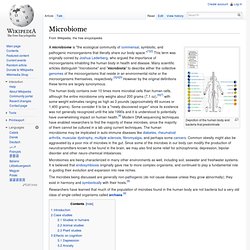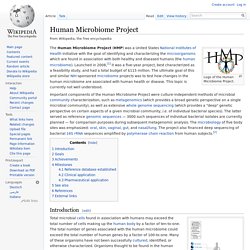

Human metagenomics - Search results. Metagenomics. Metagenomics allows the study of microbial communities like those present in this stream receiving acid drainage from surface coal mining.

Etymology[edit] The term "metagenomics" was first used by Jo Handelsman, Jon Clardy, Robert M. Goodman, and others, and first appeared in publication in 1998.[4] The term metagenome referenced the idea that a collection of genes sequenced from the environment could be analyzed in a way analogous to the study of a single genome. Recently, Kevin Chen and Lior Pachter (researchers at the University of California, Berkeley) defined metagenomics as "the application of modern genomics techniques to the study of communities of microbial organisms directly in their natural environments, bypassing the need for isolation and lab cultivation of individual species".[5] History[edit] Microbiome. Depiction of the human body and bacteria that predominate A microbiome is "the ecological community of commensal, symbiotic, and pathogenic microorganisms that literally share our body space.

"[1][2] This term was originally coined by Joshua Lederberg, who argued the importance of microorganisms inhabiting the human body in health and disease. Many scientific articles distinguish "microbiome" and "microbiota" to describe either the collective genomes of the microorganisms that reside in an environmental niche or the microorganisms themselves, respectively.[3][4][5] However by the original definitions these terms are largely synonymous.
Hmp. Logo of the Human Microbiome Project.

The Human Microbiome Project (HMP) was a United States National Institutes of Health initiative with the goal of identifying and characterizing the microorganisms which are found in association with both healthy and diseased humans (the human microbiome). Launched in 2008,[1] it was a five-year project, best characterized as a feasibility study, and had a total budget of $115 million. The ultimate goal of this and similar NIH-sponsored microbiome projects was to test how changes in the human microbiome are associated with human health or disease. This topic is currently not well understood.